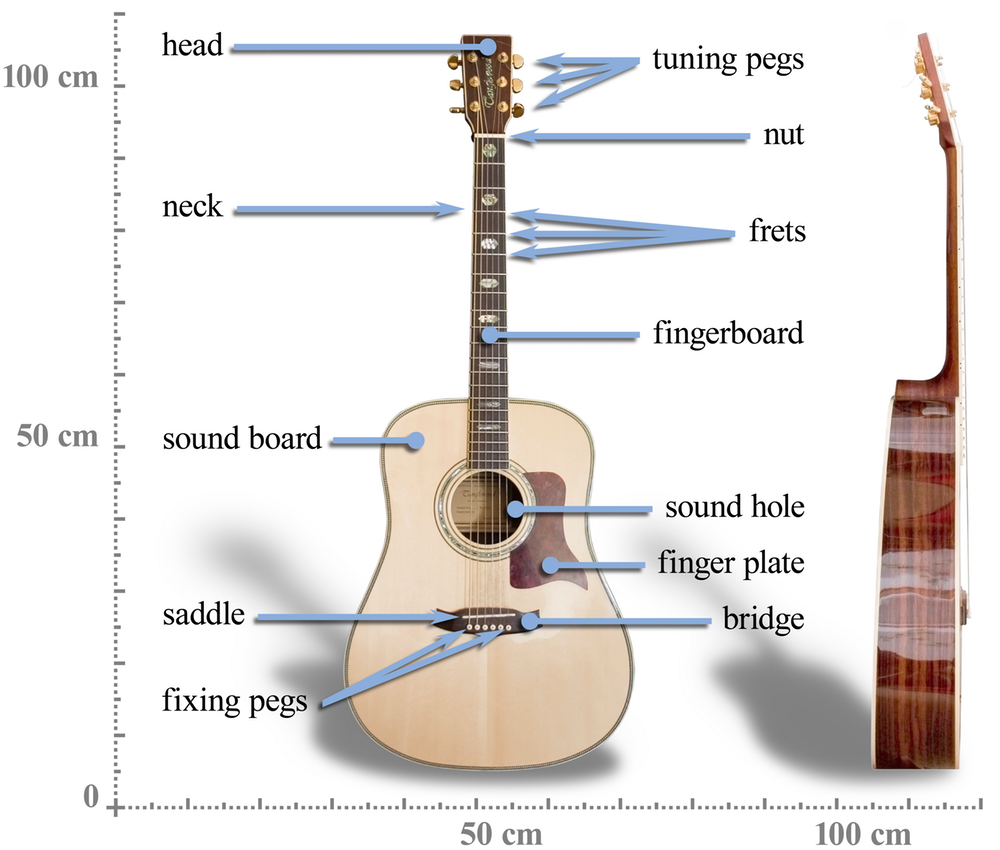Acoustic Guitar Construction
When studying acoustic guitar construction, you quickly learn two things. First, there is no single "right" way to build an acoustic guitar (though there are plenty of wrong ways). As an example, Bob Taylor (of Taylor guitars) chose to use a bolt-on neck to facilitate neck resets. People thought he was crazy to add this to acoustic guitar construction, but after many years, Taylor is one of the most respected names in the business.
Second, there are many components of an acoustic guitar's construction that drastically affect the tone and playability, some more than others. With an acoustic guitar, for example, the top wood is incredibly important. Also, the type of neck construction can affect the feel and playability.
With all this in mind, let's take a look at some principles of construction that will help you understand how acoustic guitars are literally "put together."
Body Styles
One of the most important decisions a luthier (someone who builds
guitars) must make is what type of body style they wish to use when
constructing the guitar. And often, the body style is dictated by its eventual use. If someone is building a guitar for a bluegrass player, for example, then chances are the builder will choose a "dreadnought" shape (see below). This decision is the first to affect the
guitar's overall tone and volume as well as its playability.
The Dreadnought
Perhaps
the most common body style is the "Dreadnought" guitar (named after the
warship and introduced by famed builder Martin guitars) which is known
for its deep sound and pronounced bass response. Popular with bluegrass
pickers and rock and rollers alike, the Dreadnought shape has been
widely copied since its inception.
Other Styles
There are other body styles,
each of which has its strengths and weakness. The Grand Concert style
(also called a 00) is small overall and relatively thin, so it's
comfortable for many to hold and play, though its sound is necessarily
quieter. Another style is the Grand Auditorium, which is an increasingly
popular body shape and construction due to its versatility. The Taylor
x14 series (including their very popular 814CE) use this style to great
success. As its name suggests, the Jumbo style is the largest
construction type. Essentially an enlarged Grand Auditorium style, the
Jumbo produces a large sound but is more difficult to play for many due
to its size.
Wood
In addition to body style, the type of wood used has
a dramatic impact on an acoustic guitar's timbre. An acoustic guitar
has various tonewoods used in construction that all affect the guitar's
timbre. For example, a guitar with a maple top will have a brighter,
"zippier" tone than a guitar with a cedar top, which is known for its
warm, round tone popular with fingerstyle players. So, when choosing an
acoustic guitar, knowing the effect wood can have on the tone is
crucial.
String Tension
Another significant component of acoustic guitar
construction (as opposed to, say, traditional classical guitar
construction) is the accommodation of the higher string tensions. Since
classical guitars use nylon strings, the tension is much lower than that
of steel string guitars. Steel string accoustics must be internally
reinforced to handle the increased tension, which is accomplished
through two primary construction components: stronger bracing and an
internal truss rod.
Internal Bracing
A guitar's bracing is a series of wooden
supports in the inside of an acoustic that provide stability to both the
top and back of the guitar. The challenge faced by the luthier is that
this support needs to provide structural support without impeding the
guitar's tone. There are many styles of bracing preferred by luthiers
for their tonal and durability, many of which are named for their
appearance (e.g. X-bracing, A-bracing, Ladder Bracing). The X-bracing
developed by C.F. Martin remains one of the most popular bracing styles
still in use.
The Truss Rod
In addition to stronger bracing, steel string
guitars now all contain an adjustable steel rod inside the neck known as
a "truss rod," which helps compensate for changes that alter the neck
such as temperature and humidity. Furthermore, the truss rod adds extra
strength to compensate for the tension of steel strings.
Pickups
Finally,
many acoustic guitars include onboard pickup systems to facilitate
amplification. These may be internal microphones or, more often, pickups
embedded under the saddle. Sometimes, a combination of internal
microphones and saddle pickups are used. Moreover, oftentimes onboard
preamps are installed, though many players prefer the preamps to be
external in order to eliminate excessive cutting of the wood.
Acoustic Guitar Construction - Final Thoughts
As you can see, making a functional, beautiful, yet highly playable acoustic guitar is a complex yet beautiful amalgam of many different components that, when assembled properly, yields a quality instrument.
Add Your Comments Here!
I'd love for you to be a contributor to SoMuchGuitar.com!
Just fill out the information below to add to this page. I'll be in touch about your submission soon!
